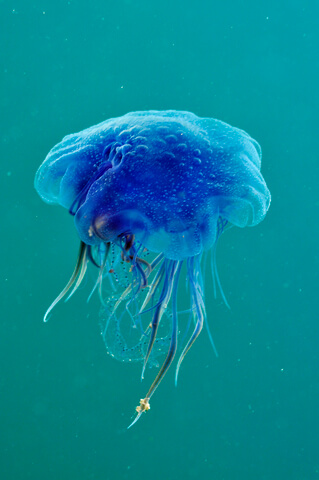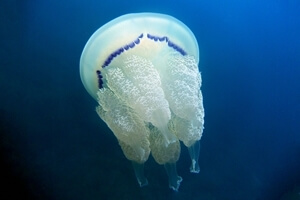It’s been getting hot in the UK over the last few weeks! And with sea temperatures across the country gradually warming up too, jellyfish season is soon to commence as these strange creatures are drawn to the warmer, shallower waters on our shores.
We spotted our first jellyfish of the year last weekend in our hometown on the Kent coast, and with temperatures rising as we head into summer, we’re bound to see more over the coming weeks.
While some jellyfish found in UK waters are harmless, others can deliver a painful sting. In this guide, we will explore the more common jellyfish species you may encounter, focusing on their stinging capabilities, to help you swim confidently.
Moon Jellyfish (Aurelia Aurita)

The Moon Jellyfish, with its saucer-shaped bell and delicate tentacles, is one of the most frequently encountered jellyfish species in UK waters. The good news is that their sting is usually mild, causing minimal discomfort to humans. Most encounters with Moon Jellyfish result in a temporary, itchy rash, similar to a nettle sting. Despite their abundance, these gelatinous creatures pose little threat to swimmers.
Blue Jellyfish (Cyanea Lamarckii)

The Blue Jellyfish, also known as the Bluefire Jellyfish, showcases a stunning blue coloration. While their tentacles can extend several meters, their stings are typically mild and rarely cause severe reactions in humans. Swimmers may experience localized itching or a rash, which can be alleviated with appropriate post-sting care. Don’t let their presence deter you from enjoying your swim, as encounters with Blue Jellyfish are usually harmless.
Compass Jellyfish (Chrysaora Hysoscella)

During the summer months, the Compass Jellyfish is a common sight in UK waters. Recognizable by the brown compass-like markings on its bell, it possesses long, trailing tentacles armed with numerous stinging cells. Although the sting of a Compass Jellyfish can be painful, it is generally considered moderate. If stung, rinse the affected area with seawater, avoiding rubbing or using freshwater, and seek medical advice if necessary.
Barrel Jellyfish (Rhizostoma Pulmo)

The Barrel Jellyfish, with its barrel-shaped bell and frilly oral arms, has become increasingly common in UK waters in recent years. These gentle giants can grow quite large, reaching up to one meter in diameter. Thankfully, their stings are mild and rarely cause significant discomfort. Swimmers may experience a slight tingling sensation or redness if they come into contact with a Barrel Jellyfish, but these effects are usually temporary and subside quickly.
What should I do if I get stung by a jellyfish while swimming?
- Get out of the water: Move away from the jellyfish to avoid further stings or getting tangled in its tentacles.
- Rinse with seawater: Use seawater, not freshwater, to rinse the affected area. This helps remove any remaining tentacles and reduces the likelihood of venom release. Avoid rubbing the area, as it can worsen the sting.
- Remove tentacles (optional): If tentacles are still adhered to your skin, you can carefully try to remove them using tweezers, a glove, or a similar object. Be cautious not to touch them directly with your bare hands to prevent further stings.
- Apply vinegar (optional): In the case of certain jellyfish stings, like those from box jellyfish or Portuguese Man o’ War (not commonly found in UK waters), applying vinegar may help neutralize the venom. However, for most jellyfish stings in the UK, vinegar is not necessary.
- Soothe with heat or cold: To alleviate pain and reduce swelling, you can either apply a hot pack or immerse the affected area in warm water for around 20-45 minutes. Alternatively, you can use a cold pack or apply a wrapped ice pack to the area. Choose whichever method provides the most relief for you.
- Take pain relief (if necessary): Over-the-counter pain relievers, such as acetaminophen (paracetamol) or ibuprofen, can be taken according to the recommended dosage to help manage any discomfort.
- Seek medical advice (if needed): If you experience severe pain, have difficulty breathing, or exhibit signs of an allergic reaction (such as swelling, hives, or difficulty swallowing), seek immediate medical attention. Additionally, if you are uncertain about the type of jellyfish or the severity of the sting, it’s best to consult a healthcare professional.
Enjoying your sea swim safely this summer
As a wild swimmer exploring the enchanting waters of the UK, encountering jellyfish is a possibility to be prepared for. By familiarizing yourself with the more common jellyfish species and their stinging capabilities, you can swim with confidence while appreciating the beauty of these marine creatures. Remember to respect their presence and enjoy your swim!




